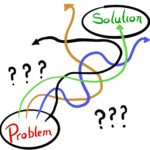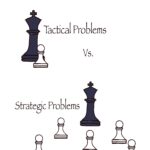9. Leadership Situational Awareness
Leadership Situational Awareness- A Planning and Decision Making Nexus
Leaders plan, decide, and communicate their vision and  direction to others for implementation. Situational awareness is the nexus that informs effective planning and decision making processes. Understanding the key constituent elements of situational awareness can take a leaders game to a more advanced level.
direction to others for implementation. Situational awareness is the nexus that informs effective planning and decision making processes. Understanding the key constituent elements of situational awareness can take a leaders game to a more advanced level.
Self:
Situational awareness for leaders stems from having an excellent understanding of your organization; its strengths, weaknesses, goals, resources (time, people, things, and money), capabilities, and competencies. With a strong foundation in self awareness, a leader can deduce decision and plans to further refine and develop each of these characteristics.
Others:
No organization operates in a vacuum, so understanding the same characteristics of other organizations, particularly those that influence yours, is critical to gauge your relative merits or deficiencies. Businesses operate in a competitive environment with similar companies, nested business, and supporting activities. The same goes with governmental institutions. This necessitates an incisive knowledge of other agencies, subordinate elements, or even other governments’ organizations. Furthermore, others awareness would be incomplete without a keen awareness of one’s clients, constituents, and customers as they also necessarily impact your relative outcomes.
Operating Environment:
However, understanding ‘yourself’ and ‘others’ is an incomplete knowledge-set for effective planning and deciding. All comparable organizations operate in a relatively congruous environment; some of it of its own making, but much of it beyond its ability to influence. So you must understand your operating environment and where it may, or may not, impact you as well others. Some examples of that environment include the constraints and restraints of imposed legislation or policy mandates, (not so) hidden agendas, weather, financial limits, market saturation points, demand and the current level of supply, seasonal trends, and so many more. Thus, understanding the environment in which you operate is a crucial third element in maintaining situational awareness.
Interplay within the nexus:
With a base of knowledge of ‘yourself,’ ‘others’ and your common operating ‘environment’ a leader can develop more effective plans and decisions through understanding the critical interplays between all three domains. Understanding how each domain influences the others enables a leader to more properly assess their situation and then develop plans or policy to improve their situation.
Example 1:
If market demand in which your business provides a product or service (environment awareness) outgrows the pace in which your capabilities can keep up (self awareness), you have a potential problem. Competitors, with an excess of that capability (others awareness) may capture that new demand and threaten your future growth possibilities. However, if you’re familiar with your competitors’ capabilities and critical needs, you may be able to align your shortcomings with their excesses. You may also be able to align your excesses with their shortages and construct opportunities for a cooperative venture, a merger, or acquisition that supports future growth or greater dominance in that market. Having an accurate appreciation of your situational awareness may give you the edge before your competition seizes that position.
Example 2:
Within governmental organizations subjected to annual budgets understanding your budget cycle is crucial (operating environment?). Critical success can depend on knowing when the ‘budget office’ will withdraw your office’s funding so they can manage the organization’s overall budget to achieve a required 100% ‘end of year execution.’ It will drive your knowledge on when to culminate your own organizational expenditures (self awareness) and preclude unfunded essential ‘end of year’ requirements.
Such knowledge can also present you with opportunistic expenditures by submitting timely and easily executable “unfunded requirement request” before the fiscal year expires. When your budget is pulled, you’ll have already financed your needs for the year. As others struggle to reclaim ‘their’ withdrawn dollars (others awareness) to fund their critical end of year needs, you’ll be better positioned to help the Budget Office achieve their close-out goals by spending the residual, un-obligated funds because of your awareness, and subsequent preparations.
Aligning your needs with making life easier for others to succeed is always a good plan; but, that’s another article. Knowing ‘yourself’, knowing ‘others’, and the ‘environment’ in which you work are all key enablers to developing effective plans and making decisions. So, how is your situational awareness? What is your proficiency and knowledge of your organizations’ ‘self’, ‘others’ and ‘operating environment’?
Interesting Links
- If you enjoyed this article, link here to our others
- See a few of our articles posted in Linkedln
Want to offer comments, the form below is for YOU!







